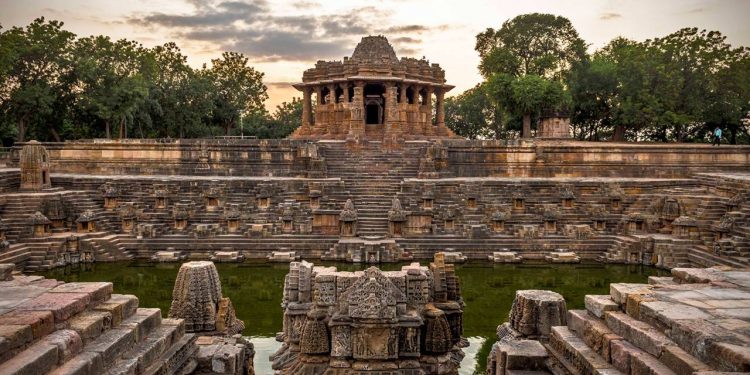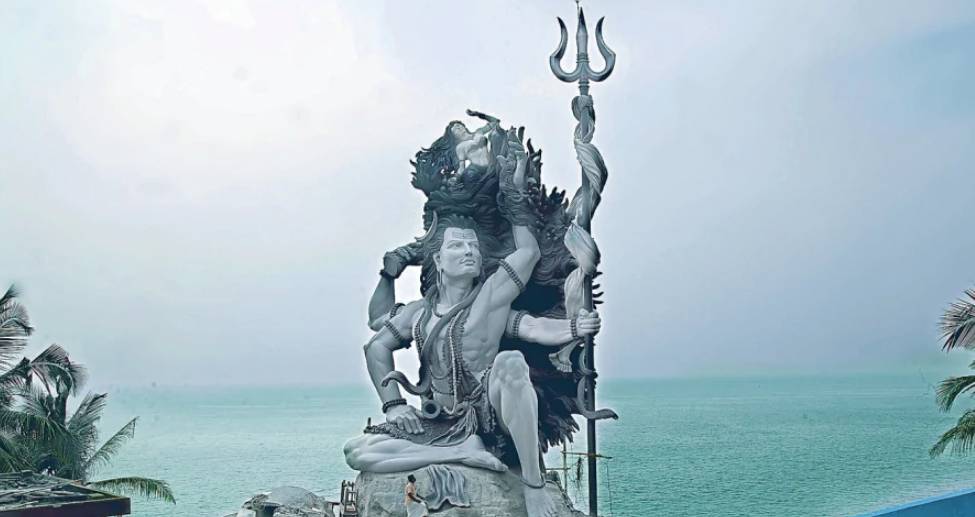It was a pleasant November afternoon and I was in Modhera (Mehsana), roughly 100 kilometres from Ahmedabad. Given the excellent road conditions, it takes under two hours to make the journey, and the place is barely half an hour away from the famous Rani ki Vav, in Patan. Modhera would have been one of those sleepy, little, nondescript villages that dot the Indian landscape. It certainly has all the characteristics, and is reminiscent of the locale that has been immortalised by celebrated author RK Narayan in his novels. But it was destined for glory, and we have to thank King Bhimdev I, the ruler of the Solanki dynasty, for that. It is here, in Modhera, that he commissioned the construction of a Sun temple in the 11th century. It sits right on the Tropic of Cancer, at a latitude of 23.5 degrees north.
The Modhera temple may not be as grand as the Sun temple in Konark, but it matches the latter in scientific and cultural precision. Unlike the Konark temple, it is not mounted on chariot wheels pulled by horses, but sits on an inverted lotus. It’s an astronomical marvel. The Modhera temple has been built in in such a way that, on the two days in a year of the Equinox — around March 21 and September 22 — when the day and the night are of equal duration, the first rays of the sun come straight on to the sanctum sanctorum of the temple, after criss-crossing the prayer hall and the main temple. Such is the genius of the construction that the rays are not allowed to be obstructed by any of the 52 pillars of the prayer hall, nor by the eight pillars of the sanctum sanctorum itself.
All you now need to do is to imagine how the architects of the Sun temple managed this feat a thousand years ago, without the aid of computer designs or technology that is taken for granted today in the construction of even basic homes. Several attempts have been made and are being made to understand what made this achievement possible, but it has remained a mystery. Just as it remains unknown as to what prompted King Bhimdev to have the temple, located on the banks of the Pushpavati river. Some accounts have it that it was to commemorate his victory over a local chieftain. Others believe that the ruler simply wanted to leave an imprint behind. A third plausible explanation is that the king considered his family to be the descendants of Surya (Sun). Whatever, the Modhera temple is a national cultural treasure and now maintained by the Archaeological Survey of India.
That November afternoon, the temple complex was besieged with hordes of visitors. This was heartening, given that it was only in recent months that many cultural monuments of Gujarat, almost forgotten and virtually abandoned by authorities, have received a boost. The aggressive promotion of such landmarks began with Narendra Modi’s chief ministership, especially in the months leading to his becoming Prime Minister. Superstar Amitabh Bachchan was roped in to market the various symbols which were not just Gujarat’s pride but also the nation’s. But, while the crowd teeming at the temple complex was welcome, it was disappointing to note that most of the people were more busy clicking selfies on their mobile phones or raucously posing for group photographs than in observing and seeking to learn the characteristics of the temple — for instance, the various carvings and positioning.
Such behaviour is, sadly, not unique to Modhera. A similar disinterest or insensitivity can be seen on display if one visits Humayun’s tomb in Delhi. Hordes of visitors come to this sprawling complex, close to Nizamuddin railway station. Even when they enter the main part which houses Humayun’s tomb and where there are signboards requesting all to maintain the respectful silence which the site demands, the people are raucous in their conduct.
But let’s return to Modhera. The Sun temple is only a shade of what it must have been in its days of glory. To begin with, the sanctum sanctorum housed a gold-jewelled idol of the Sun god. It was on this idol that the first rays of the sun fell. It was spirited away by the invader and looter, Mahmud of Ghazni. It is said that from hereon, he had proceeded to Odisha and ransacked the Konark Sun temple. Over the centuries, the Modhera temple has seen an erosion of structures. For example, the original roof was in the shape of a stepped pyramid, but that no longer exists. A few pillars at the sacred water tank have given way too.
However, even in its lesser glory, the temple is a magnificent, though compact structure — enough to still invoke awe and inspiration. The temple complex has three basic components: Gudhamandapa (shrine hall), Kunda (water reservoir), and Sabhamandapa (assembly hall). While the halls have many pillars with intricate carvings, the reservoir, which is located at the bottom of the main temple, is accessed by a flight of steps from the four directions, and is dotted by numerous small shrines. Needless to add, the architectural style is that of the Chalukyas — the Maru-Gurjara one, which is a speciality in Gujarat.
The assembly hall is located some distance away from the main shrine which also consists of the sanctum sanctorum, or the Garbhgriha. Three projections of the outer wall of the shrine hall had windows on each side, while one side had the doorway. Some of the windows are in ruins while one is entirely missing now. The sanctum sanctorum is squarely shaped and measures 11 feet from the inside. The upper cell of the main shrine housed the looted Sun idol.
The outer walls of the assembly hall are a collage of numerous carvings, with human figures, including women, in various poses. The figures of Lord Sun are seen all along too. The assembly hall also served as the place for exquisite dance performances, largely in devotion to the Sun god. The Sabhamandapa has 52 elaborately carved pillars, both short and tall.
Equally impressive is the kunda (the water reservoir). During my visit, I noticed a group of youngsters — probably students of history or architecture — seated on the steps and sketching diagrams of the various small shrines, mainly of the Vaishnavite sect. The reservoir measures roughly 176 feet from north to south and 120 feet from east to west, and is paved with stones all around.
The Modhera Sun temple is an important element in the long chain of our rich cultural heritage. Keeping the spirit alive is the Modhera Dance Festival which is organised every January by Gujarat’s tourism department. The three-day event is meant to “celebrate and venerate”, the Gujarat Tourism official website says, the “inherited treasure of performing arts of the country”. Let the tradition live on!
(The writer is Visiting Fellow at Vivekananda International Foundation. The views expressed here are personal)


















Discussion about this post